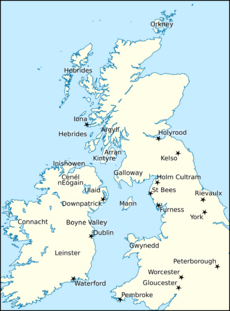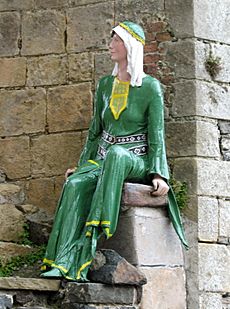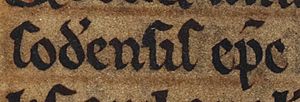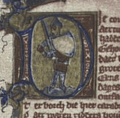Guðrøðr Óláfsson facts for kids
Quick facts for kids Guðrøðr Óláfsson |
|
|---|---|
| King of Dublin and the Isles | |

Guðrøðr's name as it appears on folio 46v of British Library Royal 13 B VIII (Expugnatio Hibernica): "Gottredum"
|
|
| Reign | 1150s–1160 |
| Died | 10 November 1187 St Patrick's Isle |
| Burial | 1188 Iona |
| Spouse | Findguala Nic Lochlainn |
| Issue |
|
| House | Crovan dynasty |
| Father | Óláfr Guðrøðarson |
| Mother | Affraic ingen Fergusa |
Guðrøðr Óláfsson (died 10 November 1187) was a powerful ruler in the 1100s. He was king of both Dublin and the Isles. The Isles were a group of islands including the Hebrides and the Isle of Man.
Guðrøðr was the son of Óláfr Guðrøðarson and Affraic. His mother, Affraic, was the daughter of Fergus, Lord of Galloway. Guðrøðr spent his life fighting rivals for his throne. He even lost about half of his kingdom to another family.
Despite being removed from power for almost ten years, Guðrøðr fought his way back. He regained control of his divided kingdom. He also became very involved in the politics of Ireland. At first, he was against the English invasion of Ireland. But he was smart and soon realized the English were becoming very strong. He decided to team up with them instead. All the later kings from his family, the Crovan dynasty, were descendants of Guðrøðr.
Contents
Becoming King of the Isles
In 1152, just before his father died, Guðrøðr visited the court of Ingi Haraldsson, King of Norway. He went there to make stronger connections with the Kingdom of Norway. This trip helped him secure his claim to the throne.
In 1153, his father, Óláfr, was killed by rival family members. Guðrøðr quickly returned to the Isles. He overthrew his cousins who had taken the throne. He then became king himself.
Guðrøðr was a more aggressive ruler than his father. In 1154, he helped Muirchertach Mac Lochlainn, King of Cenél nEógain. Muirchertach was trying to become the High King of Ireland.
Family Background and Alliances
Guðrøðr's family, the Crovan dynasty, were Norse-Gaelic rulers. They were descendants of Guðrøðr Crovan, King of Dublin and the Isles. After Guðrøðr Crovan died in 1095, there was a confusing time in the Isles. Óláfr, Guðrøðr's father, grew up in England. He became King of the Isles around 1120.
Guðrøðr's mother, Affraic, was the daughter of Fergus, Lord of Galloway. Fergus was a powerful lord in Scotland. Some sources say Affraic's mother was an illegitimate daughter of Henry I, King of England. This meant Guðrøðr was related to the English royal family. This connection was very important for his family.
His parents' marriage, probably in the 1130s or 1140s, was a smart move. It gave the Crovan dynasty strong ties to the English Crown. For Fergus, it gave him protection from the powerful fleet of the Isles. It also gave him an ally outside the influence of the Scottish king.
Another important family connection was between Óláfr and Somairle mac Gilla Brigte, Lord of Argyll. Around 1140, Somairle married Óláfr's daughter, Ragnhildr. This marriage had huge consequences later. It gave Somairle's children a claim to the kingship of the Isles. The Chronicle of Mann said this marriage was "the cause of the collapse of the entire Kingdom of the Isles."
Fighting for the Throne
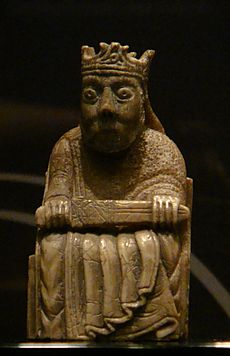
In 1154, Guðrøðr's forces helped Muirchertach in a big naval battle off the coast of Ireland. This battle was against Toirrdelbach Ua Conchobair, King of Connacht. Muirchertach's fleet included ships from the Isles. Even though Muirchertach's side barely won, he soon gained control over Dublin. He became the High King of Ireland.
This battle might have caused problems for Guðrøðr. In 1155 or 1156, his brother-in-law, Somairle, tried to take over. Somairle's son, Dubgall, was put forward as a new king. Dubgall was Guðrøðr's nephew and also had a claim to the throne through his mother, Ragnhildr.
Not everyone supported Somairle. Some leaders in the Isles were forced to agree with him. One chieftain even warned Guðrøðr about Somairle's plan.
Dividing the Kingdom
In January 1156, Guðrøðr and Somairle fought a fierce sea battle. Somairle had a fleet of eighty ships. The battle was very bloody and didn't have a clear winner. After the fight, the two brothers-in-law decided to divide the Kingdom of the Isles.
It's not clear exactly how they split the land. But it seems Somairle and his son got the southern islands of the Hebrides. Guðrøðr kept the northern parts.
Two years later, in 1158, Somairle attacked again. He had fifty-three ships. He attacked the Isle of Man and forced Guðrøðr out of the kingdom. Guðrøðr went into exile. With Guðrøðr gone, either Dubgall or Somairle became King of the Isles. Somairle held the real power.
Years in Exile
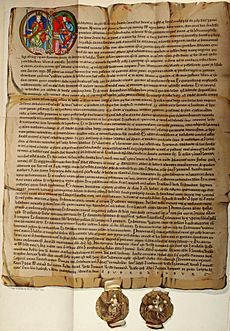
After being driven out, Guðrøðr tried to get help from the kings of England and Scotland. In 1158, records show he received money for weapons and supplies in England. He might have hoped for military help from Henry II, King of England. But Henry II was busy in France.
The next year, 1159, Guðrøðr was in Scotland. He witnessed a document for Malcolm IV, King of Scotland. Malcolm had faced problems from Somairle before. So, he might have felt sympathetic to Guðrøðr. Guðrøðr was treated with respect, but he couldn't get military help from the Scots.
It's unclear why Guðrøðr didn't ask his grandfather, Fergus of Galloway, for help. Fergus's fleet had been weakened in the 1154 battle. Also, Galloway was having its own power struggles.
Seeking Help in Norway
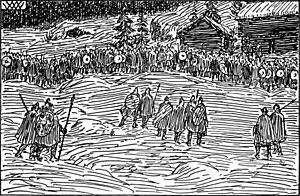
Since he couldn't get help from England or Scotland, Guðrøðr went to Norway. He visited Ingi, who was his official overlord (a higher king). In late 1160 or early 1161, Guðrøðr became important in Norway's ongoing civil war.
The Icelandic sagas say that Guðrøðr played a key role in Ingi's final defeat. Ingi was fighting against Hákon Sigurðarson. Guðrøðr, leading 1,500 men, switched sides and joined Hákon. This move helped Hákon win and led to Ingi's death in 1161.
It's likely Guðrøðr was present when Magnús Erlingsson became king of Norway in 1163 or 1164. Guðrøðr might have sworn loyalty to him.
Returning to Power
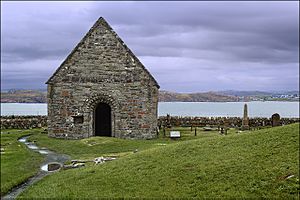
In 1164, Somairle was killed during an invasion of mainland Scotland. This was a turning point. Although some records say Guðrøðr became king again in 1160, he likely returned to the Isles after Somairle's death.
After Somairle's fall, Guðrøðr's brother, Rǫgnvaldr, briefly took the kingship. But Guðrøðr soon regained the throne. The kingdom was then officially divided between the Crovan dynasty (Guðrøðr's family) and the Meic Somairle (Somairle's descendants). This division was based on the split they made in 1156.
King of Dublin
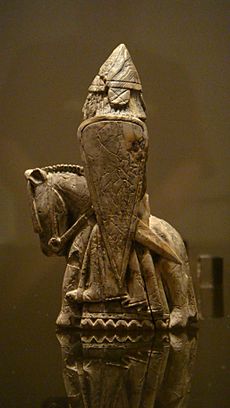
For a short time, Guðrøðr was also King of Dublin. The exact timing is a bit confusing in historical records. The Chronicle of Mann says the people of Dublin invited Guðrøðr to be their king in his third year as King of the Isles.
This move would have angered Muirchertach, the Irish overlord of Dublin. The chronicle says Muirchertach marched on Dublin with a huge army. Guðrøðr and the Dubliners fought back. They pushed back an army of three thousand horsemen. Muirchertach then left the area.
Other historical records, like the Annals of Ulster, agree with this story. But they date the event to 1162. After Muirchertach's setback, a peace deal was made. Dublin paid a large tribute to Muirchertach. This suggests that Guðrøðr was removed from the kingship of Dublin as part of the peace.
In 1176 or 1177, Guðrøðr officially married Findguala Nic Lochlainn. She was Muirchertach's granddaughter. This marriage might have been a way to make peace after Guðrøðr left Dublin.
Facing the English in Ireland
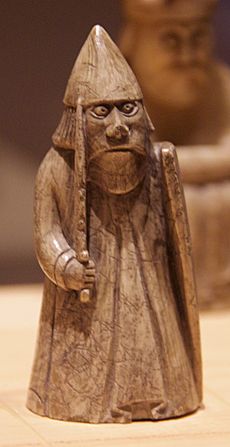
Later in his reign, Guðrøðr became involved in Dublin's affairs again. In 1166, Muirchertach was killed. This led to a fight for the High Kingship of Ireland between Ruaidrí Ua Conchobair, King of Connacht and Diarmait Mac Murchada, King of Leinster. Diarmait had controlled Dublin since 1162.
Diarmait was forced out of Ireland by Ruaidrí. But he returned in 1167 with English soldiers. In 1170, more English troops arrived, including Richard de Clare. Richard captured the city of Waterford. He then married Diarmait's daughter, Aífe. This made him heir to Leinster and Dublin.
Later that year, Diarmait and Richard marched on Dublin. They drove out the current king, Ascall mac Ragnaill, King of Dublin. Ascall and many Dubliners escaped to the "northern islands." This likely meant the Hebrides or the Isle of Man. This shows that Dubliners still had strong ties to the Isles.
Fighting the English Invasion
In 1171, Ascall returned to Dublin with warriors from the Isles and Norway. But his invasion failed completely. Ascall was captured and killed. He was the last Norse-Gaelic King of Dublin.
After Ascall's death, Ruaidrí besieged Dublin, which was now controlled by the English. He and the Archbishop of Dublin asked Guðrøðr and others in the Isles for help. They wanted Guðrøðr to block Dublin by sea.
Guðrøðr and the Islesmen were worried about the English taking over the region. So, they quickly sailed about thirty ships full of warriors into Dublin's harbor. This was a huge military effort by the Irish. But the blockade failed, and Dublin remained in English hands.
Teaming Up with the English
Guðrøðr eventually changed his strategy. He realized the English were a rising power in the Irish Sea. He decided to align himself with them. A key part of this alliance was the marriage of his daughter, Affrica, to John de Courcy. John was one of the most powerful English conquerors in Ireland.
In 1177, John de Courcy led an invasion of Ulaid (an area in modern-day Northern Ireland). He captured the main town and ruled with some independence. The marriage between John and Affrica likely helped his success. Guðrøðr probably gave John military support.
This alliance was important for both sides. The rulers of Ulaid and Mann had a history of conflict. So, John's marriage to Affrica might have been a reason for his attack on Ulaid. Guðrøðr also formalized his own marriage to Findguala in 1176/1177. This connected his family to the Meic Lochlainn, who were also enemies of Ulaid.
These alliances meant John was protected on his sides. Guðrøðr could use John's campaigns to settle old scores with Ulaid. This shows how the English conquest of Ireland changed politics in both Ireland and the Isles.
Church Activities
Guðrøðr continued his father's work in reforming the church in the Isles. He confirmed his father's grant to the abbey of St Mary of Furness. This gave the monks the right to choose the Bishop of the Isles.
Guðrøðr also gave land to the English priory of St Bees. He gave land at Myroscough to the abbey of Rievaulx in England. A monastery was built there. He also gave trading rights to the monks of monastery of Holm Cultram.
The church area in Guðrøðr's kingdom was the Diocese of the Isles. In 1152, the Pope decided to make Dublin an archdiocese. This meant the Bishop of the Isles might become controlled by the Archbishop of Dublin. This would have threatened Guðrøðr's power.
Guðrøðr's trip to Norway in 1152 might have been to find a Scandinavian church leader to protect his diocese. In 1154, the Diocese of the Isles officially became part of the new Norwegian church province, the Archdiocese of Niðaróss. This helped keep the kingdom's church independent from Dublin.
Death and Family
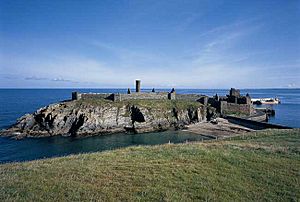
Guðrøðr had four children: Affrica, Rǫgnvaldr, Ívarr, and Óláfr svarti. The Chronicle of Mann says Findguala was Óláfr svarti's mother. He was born before his parents were formally married. The mothers of the other children are not known.
Guðrøðr died on 10 November 1187 on St Patrick's Isle. This islet might have been a royal home. The next year, Guðrøðr was buried on Iona. St Oran's Chapel on Iona is the oldest building there. It was built around the mid-1100s. Guðrøðr's family likely supported its construction.
The chronicle says Guðrøðr wanted his younger son, Óláfr svarti, to be king because he was born "in lawful wedlock." This might show Guðrøðr wanted to strengthen the idea of kingship in the Isles. It was also the first time a Crovan king tried to name his successor. This might have been because of his own struggles with rivals.
However, the Islesmen chose Rǫgnvaldr to be king instead. Óláfr svarti was just a child. Rǫgnvaldr was a strong young man ready to rule. Guðrøðr might have wanted Rǫgnvaldr to rule temporarily until Óláfr svarti was older.
Rǫgnvaldr later teamed up with the Meic Somairle. He might have briefly reunited the entire Kingdom of the Isles. But he was later opposed by Óláfr svarti. The conflict between Guðrøðr's sons continued for many generations.
Images for kids
-
A 14th-century drawing of Fergus, Lord of Galloway from Leiden University Library Letterkunde 191 (Roman van Ferguut).
-
Image a: Maughold IV, a Manx runestone showing a sailing ship. The kings of the Isles were powerful because of their fleets.
-
Dubgall's name as it appears on folio 16v of British Library Cotton Domitian A VII (the Durham Liber vitae): "Dunegal filius Sumerledi"
-
A queen gaming piece from the Lewis chessmen.
-
A 19th-century drawing of the seal of Richard de Clare, Earl of Pembroke. It shows a knight on horseback and a foot soldier.
-
A bishop gaming piece from the Lewis chessmen.


